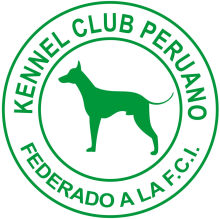 Founded on 1 July 1960, Peru's national canine organisation, the Kennel Club Peruano
(KCP) celebrated its 50th anniversary in 2010. Its headquarters are located in Lima,
the Ciudad de los Reyes or the three times crowned City of the Kings. The KCP is
the organisation in charge of keeping Peru's Studbook, a responsibility conferred
by the Ministry of Agriculture. Originally named the Asociación Sporting and Kennel
Club Peruano, the club later became known as the Kennel Club Peruano (KCP).
Founded on 1 July 1960, Peru's national canine organisation, the Kennel Club Peruano
(KCP) celebrated its 50th anniversary in 2010. Its headquarters are located in Lima,
the Ciudad de los Reyes or the three times crowned City of the Kings. The KCP is
the organisation in charge of keeping Peru's Studbook, a responsibility conferred
by the Ministry of Agriculture. Originally named the Asociación Sporting and Kennel
Club Peruano, the club later became known as the Kennel Club Peruano (KCP).
Dogs in Peru
Dogs have been around in Peru just as long as mankind has been present in the central
part of South America. Since earliest civilisations, dogs have been at the sides
of Peruvian ancestors, remaining there over the course of the country's various
cultural evolutions.
The first traces of dogs were found at Jaywamachay in the Andes, where remains dating
back to the Lithic Age were unearthed at a site 9,000 - 11,000 years old located
in the Ayacucho Valley. Remains dating back to the Formative Period were found on
both the coast and in the Sierra Central, for instance at Ancón, a site to the north
of the Chillon Valley, where remains of dogs belonging to at least four different
breeds, all with hair, were found in the cemeteries discovered by Nehring.
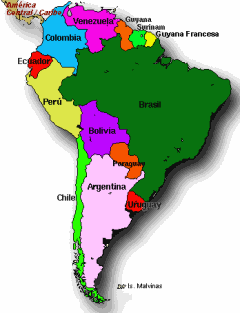 Peruvian prehistory consists of three periods of unification: the Ancient Horizon
civilisation (Horizonte Temprano - Horizonte Chavín), the Middle Horizon civilisation
(Horizonte Medio - Horizonte Tiahuanaco or Tiahuanaco-Wari) and the Late Horizon
civilisation (Horizonte Tardío - Horizonte Tawantinsuyu). First depictions of dogs
appear on pottery belonging to the Vicús civilisation (500 BC - 400 AD). This civilisation
owes its name to a hill on the territory of the old Pabur domain, to the East of
Piura, where anthropomorphic, phytomorphic and zoomorphic sculptures are often to
be found. In addition to the actual modelling, these are decorated with motifs painted
in red or made using negative impression.
Peruvian prehistory consists of three periods of unification: the Ancient Horizon
civilisation (Horizonte Temprano - Horizonte Chavín), the Middle Horizon civilisation
(Horizonte Medio - Horizonte Tiahuanaco or Tiahuanaco-Wari) and the Late Horizon
civilisation (Horizonte Tardío - Horizonte Tawantinsuyu). First depictions of dogs
appear on pottery belonging to the Vicús civilisation (500 BC - 400 AD). This civilisation
owes its name to a hill on the territory of the old Pabur domain, to the East of
Piura, where anthropomorphic, phytomorphic and zoomorphic sculptures are often to
be found. In addition to the actual modelling, these are decorated with motifs painted
in red or made using negative impression.
On the left, a Vicús pot, and on the right, a huaco Mochica depicting a Peruvian
Hairless Dog.
Around 100 BC the Mochica Civilisation emerged, a civilisation which was to develop
exquisite, fine and realistic pottery. The realistic depiction of dogs produced
by the pottery-makers of that time enable us to recognise the Peruvian Hairless
Dog, together with its haired counterpart. Despite the amount of time that has passed,
they can be seen to have the same traits as such dogs now show. These dogs aroused
interest through their loyalty and good guard-dog qualities.
The Mochica civilisation was superseded by the Sicán civilisation, a civilisation
owing its name to the ceremonial city of that name. Following in the footsteps of
the Moches, though without achieving their stylistic level and quality, the Sicán
pottery-makers also depicted the Peruvian Hairless Dog in a very characteristic
and detailed way in their sculptured pottery - depicting it in a stereotype way,
with concentric lines around the eyes, warts on the face, scratches around the body
and erect ears. This style was to be developed later by the Chimú between 1100 and
1470 AD in their predominantly black pottery. The Sicán civilisation covered a period
of transition between the Wari hegemony (700 - 1100 AD) and the Incas.
The emergence of the Incas announced dark times for dogs, with the sun-worshipping
Incas dislodging the former pre-Inca political and religious structures where the
presence of dogs - enjoying the interest of the elite - is highlighted in works
of art. In great contrast to the preceding periods, there are few depictions of
dogs in Incan art during this period preceding the Conquista. This can be seen as
a sign of the change in the way dogs were regarded. In spite of this, the different
ethnic groups living along the coast, enslaved as a result of war or the system
of reciprocity, retained the habit of worshipping its effigy, drawing nourishment
from it, and burying their dead with their dogs, a custom that the Incas tried without
success to stamp out.

With the defeat of the Incas, the situation of the native breeds changed abruptly
and a number of pre-Hispanic dogs disappeared altogether. This was not just due
to their extermination but also through crossing with European breeds imported by
the Spaniards. In the case of the “Viringo”, an ancient Moche word for the Peruvian
Hairless Dog still used in Piura and surroundings, the strength of the genetic factor
causing its hairlessness has enabled such dogs to remain our companions with unchanged
characteristics - despite the centuries that have passed by.
There can be no doubt that this breed has been able to survive till now thanks in
part to its reputation, widespread among the population of the Northern coast, of
it having curing "qualities". Its acceptance was aided not only by these qualities,
but also by its skills as an exterminator of the rodents which used to cause extensive
damage to crops. A selection occurred unconsciously, preserving the breed as it
was in antiquity.
Chimú sculpture and a Chancay biglobular artefact representing the Peruvian Hairless
Dog.
A breed of Peruvian origin
Peru has only one breed recognised internationally - the Peruvian Hairless Dog.
It was officially recognised - and confirmed as a breed originating in Peru - by
the FCI General Assembly of 12 June 1985 in Amsterdam (the Netherlands), being given
the standard number 310. Since then, an increasing number of people have started
showing interest in breeding the dogs with their marked racial features, enabling
a few representatives to be among the prize-winners at shows and to top national
rankings, as was the case in 2009 with the dog LUNA (VASQUEZ). This year, in the
light of the advances made in genome studies, a proposal has been made to the FCI
Standards Commission to change the standard, recognising the variety with hair as
a variety of the breed. This change is expected to come into force from 2011 onwards.
About the club
Before the club was founded, canine events were organised by the Asociación de Médicos
Veterinarios de Lima, whose objectives were not necessarily breeding purebred dogs.
These events represented the starting point for dog-lovers - with Reynaldo Pochopp
at their head - to consider the need to found a club which, in addition to organising
dog shows, would also be responsible for managing Peru's studbook. The KCP began
its work on 1 July 1960 with Reynaldo Pocchop as its first president. At the head
of a group of enthusiasts, he led the club on a long journey, guiding it into the
21st century with new perspectives for the future, both as a club and with regard
to breeding.
The first show organised by the KCP took place on 24 - 25 November 1962 as part
of the Club Regatas de Chorrillos. It was judged by the well-known doctor Frank
Porter Miller from the American Kennel Club (AKC), a man with an unparalleled passion
for dogs, whether purebred or not, and whose dogs had won the famous Kentucky Derby
in 1951. A little more than 150 dogs took part in this show, with the honours going
to the little Italian Greyhound, JACQUELINE, belonging to José Castañeda, This first
show was to mark the start of Peru's cynology activities. Thanks to the work of
the club's directors and members, the club has been successful in spreading the
passion for dogs, achieving the high standard now found. This was to be witnessed
at the recent show of the Americas and Caribbean Section, which took place in our
capital city in commemoration of the club's Golden Anniversary. Events such as the
1988 World Dog Show, SICASUD in 1983, the Championships of the Americas and the
Caribbean Section in 1994, 2002 and 2010, and SICALAM in 1998 and 2008, have become
historic milestones for the club, during which the fruits of Peruvian breeding could
be shown to the entire region and the world.
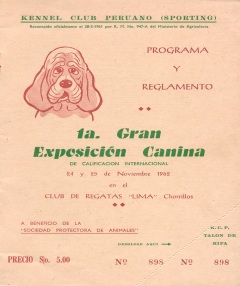
|
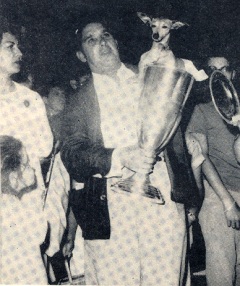
|
On the left, cover of the catalogue of the first show held by the KCP. On the right,
the small Italian Greyhound, JACQUELINE, winner of the show, in the arms of its
owner.
The second historic milestone in the life of the KCP was its affiliation to the
Fédération Cynologique Internationale (FCI), adopted at the General Meeting held
on 27 - 28 June 1963 in Portugal, after nine meetings held during the four months
of discussions.
Activities
The KCP's managing body is its 7-member Management Committee (Consejo Directivo).
The club's premises are in Miraflores, a district of Lima. The club has a Director
and four permanent employees. KCP funding is provided by its 170 members, from whose
midst the members of the management board and committees are elected every two years.
Mandatory committees are stipulated in the statutes and include the Audit Committee
and the Disciplinary Committee. To achieve its objectives, the elected officials
appoint the directors of Registers and Subsidiaries, as well as the members belonging
to the Breeding Committee. In addition, there are other technical committees, including
the Genealogy Committee and the Board of Judges which works to support and provide
assistance in dealing with technical aspects and is composed of all official judges
in possession of a valid license, without distinction of breed or specialty. All
posts within the club are held on a voluntary basis.
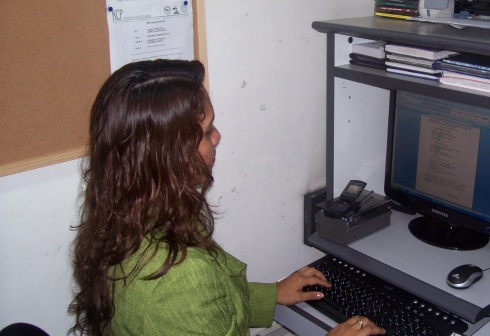
The KCP manages the Studbook (RD) for the dogs with a genealogy going back three
complete generations in accordance with FCI Circular Nr 17 of 15 September 1975,
and the Initial Register (RI) in which Peruvian Hairless Dogs awaiting a three-generation
pedigree are listed (once this is achieved, they are transferred to the Studbook).
As part of a new breeding strategy which begun in 2010, the KCP has changed its
procedure for issuing genealogy documents, as well as the format of national and
export pedigrees, with them now bearing features guaranteeing their authenticity.
Moreover, in addition to the obligation to implant microchips when registering all
puppies in a litter, the breeds most prone to hip dysplasia must pass the required
test before being deemed fit for reproduction. In 2009, 712 litters (with 3142 puppies)
were registered, demonstrating the upward trend of the last few years as well as
the arrival of new breeders, in itself a fact reflecting the annual increase in
applications for kennel names.
The KCP has 14 judges, including 4 international, 9 national, and 2 working judges.
It has two subsidiaries, the Club Canófilo Arequipa (CCA) and Caxamarca Kennel Club
(CKC), in addition to the clubs for specific breeds such as the Asociación Peruana
de Perros Pastores Criadores Alemanes (MAP APA), the Boxer Club del Perú (BCP),
the Asociación Peruana del Mastín Napolitano (APEMANA) and the Club del Rottweiler
(CDR).
On average, 40 shows are held each year, whether regional, national, Latin-American
or international. In 2010 11 CACIB-awarding shows were held, including the Circuito
de Las Américas y el Caribe, the Section's Dog Show and the region's most important
show, which were organised by the KCP. In addition, Agility Championships are held.
Top-rated judges are invited to these, illustrating the increase in popularity this
sport is witnessing in our country.
Finally, the development of Peruvian cynology reflects, in part, Peru's current
economic growth and the effectiveness of the administrative work being done by its
proponents. These two aspects have enabled breeders to rely on dedicated resources
for improving their kennels, thereby raising the average level of such activity
in our region. The club's management committee is committed to encouraging measures
aimed at making use of current-day technologies, such as DNA tests, sperm-banks
and tests for detecting the various hereditary problems which dogs are prone to.
This can all be seen as part of the functional health concept promoted by the FCI.
Looking to the future, the KCP is facing new challenges. These will be met through
the joint efforts of its management and members.